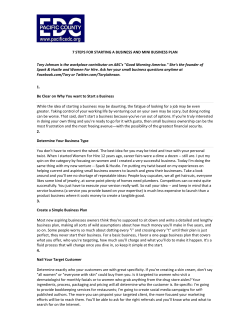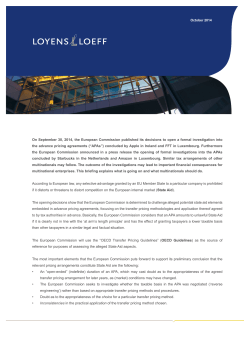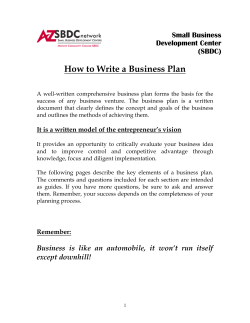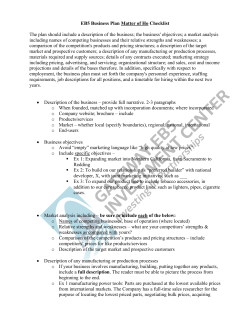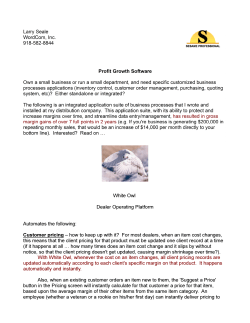
Course notes
Competitive Intelligence Week 7 Competing Across Time 1 Outline Competing Dynamics Strategic Commitment Defining Commitment Commitment and competition Flexibility and Options Dynamic Pricing Uncooperative pricing Cooperative pricing 2 Competition Firm has no influence on competition Reduce costs so that MC < P Differentiation Firm can influence competition Oligopolistic structure 3 Strategic Commitment (1) Major strategic decisions Major investments Vs loss of flexibility Sending clear signals to competitors Visible and Understandable Credible (no bluff and irreversible) • Hard and costly to reverse • Ex. Investments, most favoured customer clause, public statement about competitive moves 4 Marchionne's grand plan is to create a global car giant by combining the best pieces of Fiat and Chrysler. The strategy makes sense on paper .... "Chrysler can make it," says Hall. "The question is, how committed is Fiat to saving Chrysler?" 5 Strategic Commitment (2) Affects competition Induces competition to behave less aggressively Induces competitors to become more aggressive Other factors Capacity utilisation rates, horizontal differentiation 6 Strategic Commitment (3) Tough Commitments (No Matter What) Cournot: Capacity expansion Bertrand: Price reduction Soft Commitments (Else) Cournot: Capacity adjustment Bertrand: Price adjustment 7 Cournot Revisited 8 Cournot Equilibrium (Chap 5) Firms adjust quantities (Soft Commitment) Market P = 100 – Q and MC = 10 Market: P = 100 – Q1 –Q2 ∏1 : (100 - Q1 - Q2g) x Q1 – 10Q1 ∏1 : (100Q1 - Q12 - Q1 Q2g) – 10Q1 ∏1 : 90Q1 – Q12 –Q1Q2g d∏1/dQ1: 90 – 2Q1 - Q2g =0 Q1 = 45 - .5Q2g and Q2:= 45 - .5Q1g Q1 = 45 - .5 (45 - .5Q1) = 30 P = 100 – 30 -30 = 40 ∏ = $30 x 30 = 900 Sequential Decision: Stackelberg Model One firm takes the lead (Tough Commitment) P = 100 – Q1 –Q2 100 - Q1 – (45 - .5Q1) Q1 = 55 - .5Q1 ∏1 = 55Q1 - .5Q12 - 10Q1 d∏1/dq = 45 - Q1 = 0 Q1 = 45 Q2 = 45 - .5Q1 = 22.5 P = 100 -45 – 22.5 = 32.5 ∏1 = (45 x 32.5) – 10 x 45 = 1,012.50 ∏2 = (22.5 x 32.5) – 10 x 22.5= 506.25 10 Response to commitment As in Stackleberg model, firm 2 adopts strategic substitutes adjustment (e.g. Cutback, reduce output as in Cournot) If firm 2 responds aggressively, it adopts strategic complements (More action, reduce prices as in Bertrand) Other adjustment/responses: Prices, quantities, R&D, advertising, sales, channels 11 Pricing Levels Monopolistic pricing (MR = MC) Competitive pricing (P = MC) Cournot equilibrium (Q adjustments) Bertrand equilibrium (P adjustments) Horizontally differentiated No differentiation (competitive pricing) 16 Pricing Levels Monopoly ∏: MR = MC Q = 45, P = $55, ∏ = $2,025 Cournot Model Q = 30, P = $40, ∏ = $900 Stackelberg Model Q=45/22.5, P = 32.5, ∏ = 1,012.5/506.25 Bertrand Model Q = 45/45, P = 10 ∏ = 0 Collaborative pricing (Collusion?): Q = 22.5, P = $55 = $1012.50 Dynamic Pricing Why do firms in some markets seem to be able to coordinate their pricing behavior and avoid costly price wars, while in other markets intense competition is the norm? 18 Decision Theory Anticipating competitors’ moves 19 Game Theory p. 253, Q.3 Z is First Mover Walmart Zellers(?) Keep Prices Drop Prices Keep Prices 200/250 150/280 Drop Prices 230/190 180/220 If Z keeps prices, then W drops prices: Z = 150 If Z drops prices, then W drops prices: Z = 180 Z should drop prices to minimize loss (-30) 20 Decision Tree Z keeps : W keeps .5 x 200 = 100 W drops .5 x 150 = 75 175 Z drops: W keeps .5 x 230 = 115 W drops .5 x 180 = 90 205 21 Decision Tree Z keeps : W keeps .8 x 200 = 160 W drops .2 x 150 = 30 190 Z drops: W keeps .1 x 230 = 23 W drops .9 x 180 = 162 185 22 Dynamic Pricing Example: Shell / Exxon Situation: P = 100 – Q, MC = 20 Price = 40, Q = 30, ∏ = 600 per firm Maximum price (Monopoly): Price = 60, Q = 20, ∏ = 800 per firm Cournot: Price = 47.67, Q = 26.67, ∏ = 317 per firm Price competition: Price = 20, Q = 40 ∏ = 0 per firm 23 Shell’s Decision (p. 236) Currently Or 11.54 weekly Collaborative ∏ = 800, P = 60 ∏ = 600, P = 40 Or 15.38 weekly Non collaborative scenario One week trial ∏ = 0, P = 60 Revert back to current situation P = 40, ∏ = 11.54 weekly Or 11.54 x 51 weeks= 588.54 25 Nash Equilibrium: Cooperative Pricing Exxon Yes Shell No Yes 800 / 800 589 / 612 No 612 / 589 600 / 600 26 Shell’s Decision Tree Price Increase .5 Exp(Profit) Exxon Follows 400 .5 Exp(Profit) Exxon doesn’t 295 695 No Increase Exp(Profit) 600 27 Shell’s Commitment Announces that prices will go up Announces that competitors’ prices will be immediately matched (“We will not be undersold”) Tit-for-tat strategy 28 Exxon’s reaction (Discount rate = 10%) Exxon (non-collaborative): 23.08 + 11.54/(1.002) + 11.54/(1.002)2 + 11.54/(1.002)3 + ... + 11.54/(1.002)n = 582 Exxon (collaborative): 15.38 + 15.38 /(1.002) + 15.38 /(1.002)2 + 15.38 /(1.002)3 + ... + 15.38 /(1.002)n = 760 Remember that: if FV = PV (1+r)n then PV = FV/(1+r)n 29 Competitive Pricing Strategies Collusion pricing (ex. OPEC, commodity marketing boards) Non Cooperative Monopoly price / n firms Bertrand: P = MC where Profit = 0 Cooperative Through rationality (NPV) Power and retaliation … Coordination … Market Structure… Facilitating Practices … 30 Power and Retaliation Tit-for-Tat (niceness, provocabiblity, forgiveness); “we will not be undersold” Grim Trigger “we will drop our prices until you choke to death” 31 Coordination Misreading competitors and possible effects Traditions, conventions, firms’ status and role Market structure and facilitating practices … 32 Market structure and Cooperative Pricing Homogeneity of goods or offer (-) Market concentration (+) Reaction speed and information (-) Order size and frequency (-) Firms’ asymmetries (-) Price sensitivity (-) 33 Price Competition and Facilitating Practices Price leadership through economies of scale or from other forms (+) Advanced Announcements (+) Strategic commitment (+) Buying power of customers - Most favored customer clause - Uniform price delivery (+) 34 Non Cooperative Pricing Managerial incentives (sales, volumes and market share) Industry cycle (growth, maturity, decline) Short term or long term views (and motivations) Managerial egos Managerial incompetency Bad mannered managers 35 Wrap up Market structure, Number of firms and Price competition Commitment Pricing equilibrium: Anywhere from monopoly to pure competition Pricing strategies: Anywhere from collusion to grim trigger Pricing behaviors: Anywhere from civilized to wild Importance of industry analysis 36
© Copyright 2025
